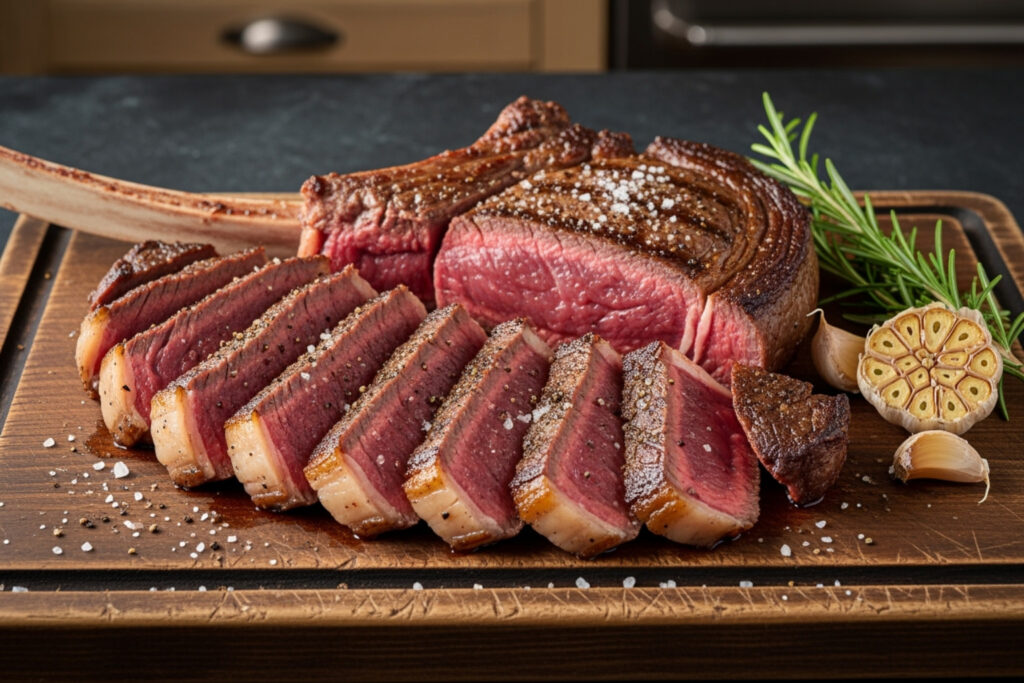What Makes a Tomahawk Steak a Showstopper?
A 2 lb tomahawk steak is more than just a piece of meat – it’s a culinary event that transforms any meal into an unforgettable experience. This massive bone-in ribeye steak, with its signature 5- to 8-inch “handle,” resembles something straight out of The Flintstones and is guaranteed to make an impression at your dinner table.
Quick Facts About 2 lb Tomahawk Steaks:
- Cut: Bone-in ribeye from ribs 6-12 of the cow
- Weight: Typically 1.5-3 pounds (2 lbs is perfect for 2-4 people)
- Thickness: About 2 inches thick
- Bone: Frenched rib bone left attached as a “handle”
- Price: Around $65-130 depending on grade and aging
- Best Cooking Method: Reverse sear (low heat, then high heat sear)
- Key Feature: Rich marbling creates intense, beefy flavor
The tomahawk is essentially a ribeye steak that hasn’t been fully separated from its rib bone. This bone is “frenched” – meaning the meat and fat are cleaned off to create that dramatic handle effect. While the bone doesn’t add much flavor, it serves as a natural handle for flipping and creates an absolutely stunning presentation.
What makes this cut special is the rich marbling throughout the meat. This intramuscular fat melts during cooking, creating the tender, juicy texture that ribeyes are famous for. The spinalis muscle (ribeye cap) wraps around the main eye of the steak, adding even more buttery richness.
As one grilling expert puts it: “If there’s a steak that resembles caveman food, it is the tomahawk ribeye.” That prehistoric appeal, combined with steakhouse-quality flavor, makes the 2 lb tomahawk steak the ultimate choice for special occasions or when you want to seriously impress your guests.
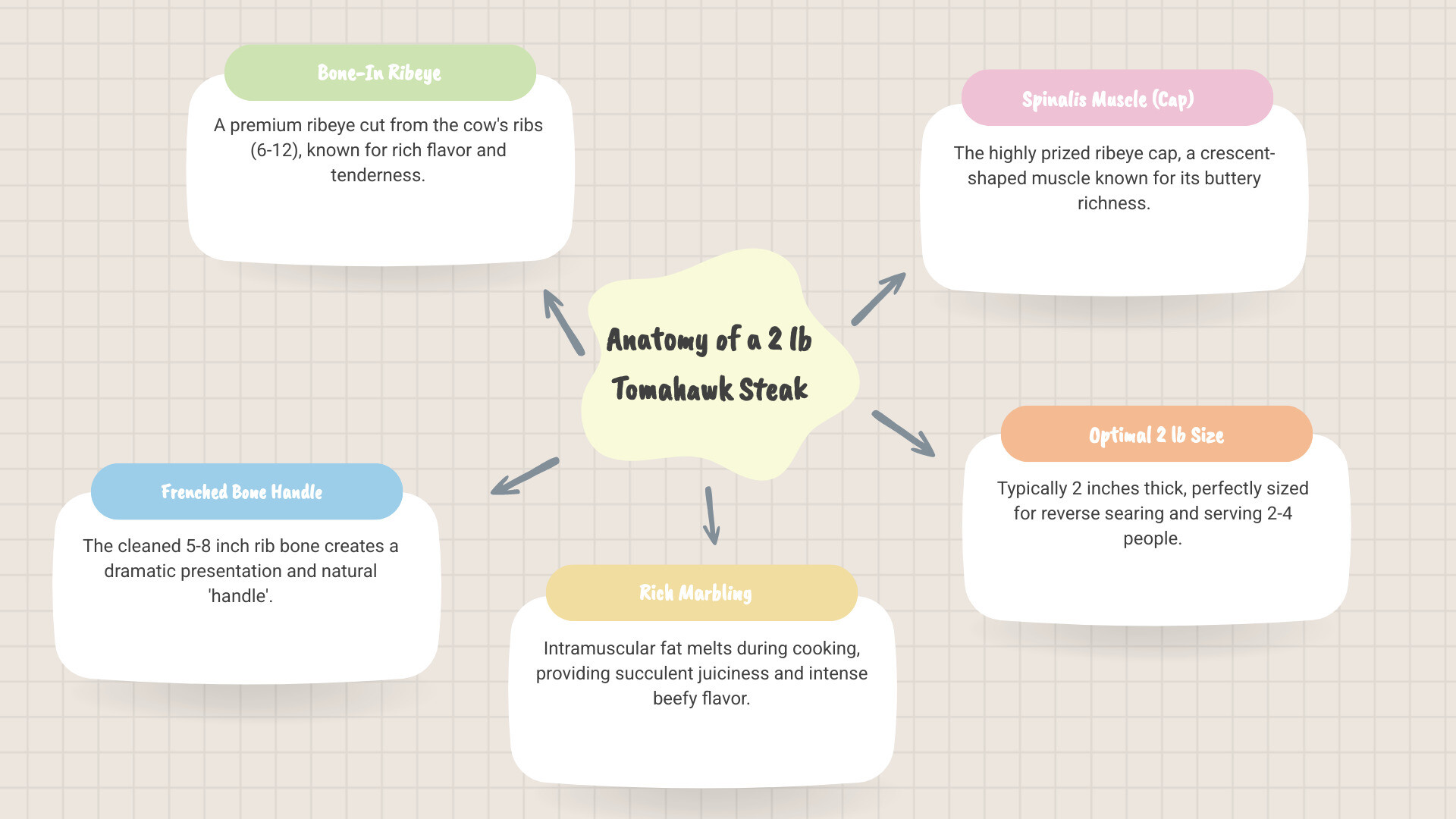
Quick 2 lb tomahawk steak definitions:
Sourcing and Selecting Your Perfect Cut
Finding the perfect 2 lb tomahawk steak is like hunting for treasure – and here in New York City, when you find that beautiful, well-marbled cut, you’ll know you’ve struck gold. This isn’t your everyday grocery run; it’s the beginning of creating a truly memorable dining experience.
Sourcing the Perfect 2 lb Tomahawk Steak
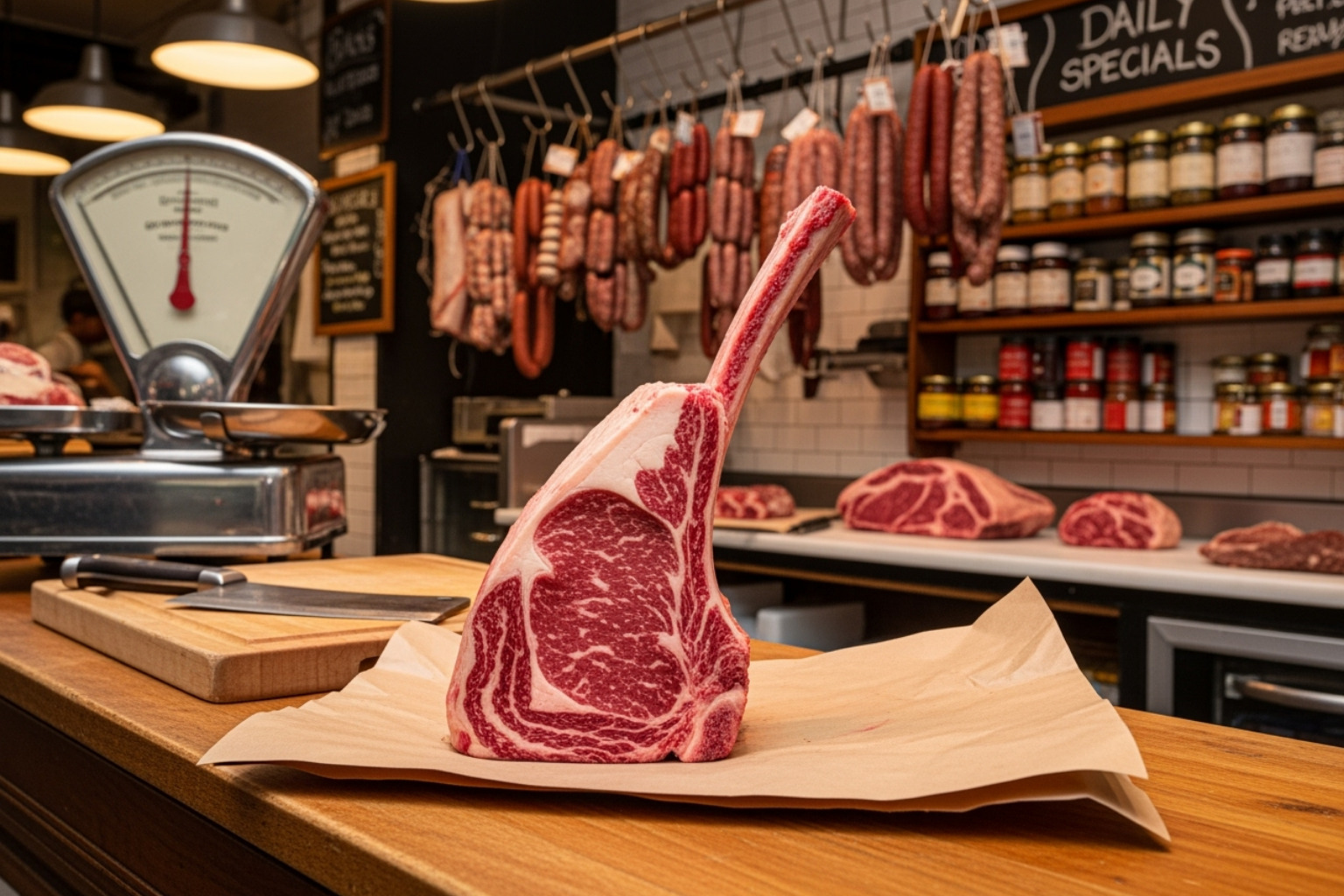
Your best bet for sourcing a 2 lb tomahawk steak is your local butcher shop. These culinary artisans are like having a personal steak consultant – they know their cuts inside and out, can tell you exactly where the beef came from, and often can custom-cut your steak to the exact weight and thickness you want. Plus, they genuinely love talking about meat (in the best way possible).
If a specialty butcher isn’t available in your area, high-quality grocery stores with dedicated meat departments can also deliver excellent results. The key is knowing what to look for when you’re standing in front of that meat case.
USDA grade is your first checkpoint. Prime grade is the gold standard – it’s what fancy steakhouses use, with incredible marbling that creates that melt-in-your-mouth experience. Choice grade is also fantastic and offers great value with slightly less marbling but still delivers amazing flavor.
The marbling itself tells the whole story. Those white streaks running through the red meat aren’t just pretty patterns – they’re flavor highways. When that fat melts during cooking, it bastes the meat from the inside, creating the rich, buttery taste that makes ribeyes legendary.
Look for a prominent spinalis muscle – that’s the outer cap of the ribeye that wraps around like a meaty hug. This section is often considered the most tender and flavorful part of the entire steak.
Your 2 lb tomahawk steak should be about 2 inches thick with a dramatic bone length of 5 to 8 inches. This thickness is crucial for achieving that perfect contrast between a beautifully seared crust and a tender, juicy interior. The long bone might seem purely theatrical, but it actually makes a great handle for maneuvering this hefty piece of meat.
Supporting your local meat purveyors not only gets you better quality and personalized service, but it also strengthens your community’s food culture. These folks are passionate about what they do, and that passion shows up on your plate.
What is the Typical Cost?
Let’s talk numbers, because a 2 lb tomahawk steak is definitely an investment in your dining experience. Several factors influence the price, and understanding them helps you make the best choice for your budget.
Weight is the obvious starting point – while we’re focusing on 2-pound steaks, tomahawks typically range from 1.5 to 3 pounds. Grade makes a significant difference too, with Prime cuts commanding premium prices over Choice cuts.
Aging can really bump up the cost. Dry-aged steaks spend weeks in carefully controlled environments, developing intense flavors and incredible tenderness. It’s like wine aging – time creates something special, and you pay for that change.
Your source matters for pricing too. Local butcher shops might charge more than big box stores, but you’re paying for expertise, quality, and often better sourcing practices.
Generally, you can expect to pay anywhere from $65 to $130 for a quality 2 lb tomahawk steak. A standard Choice grade might run around $65-80, while a Prime or dry-aged version could easily reach $100-130 or more.
Here’s the beautiful part: even at the higher end, cooking this showstopper at home costs a fraction of what you’d pay at a high-end steakhouse. Restaurant tomahawk steaks often run $80-150 per person, so preparing one at home for 2-4 people is actually an incredible value. You get all the drama and flavor of a special occasion meal while staying in your own backyard.
How to Perfectly Cook a 2 lb Tomahawk Steak
Here in New York City, we’ve learned that cooking a 2 lb tomahawk steak is truly an art form that transforms your kitchen into a high-end steakhouse. This magnificent cut demands respect and the right technique – but don’t worry, it’s absolutely achievable at home with the reverse sear method.
The reverse sear is our go-to approach because it solves the biggest challenge with thick steaks: getting an even cook from edge to edge while still achieving that gorgeous, caramelized crust. Think of it as cooking backwards – low and slow first, then a blazing hot finish.
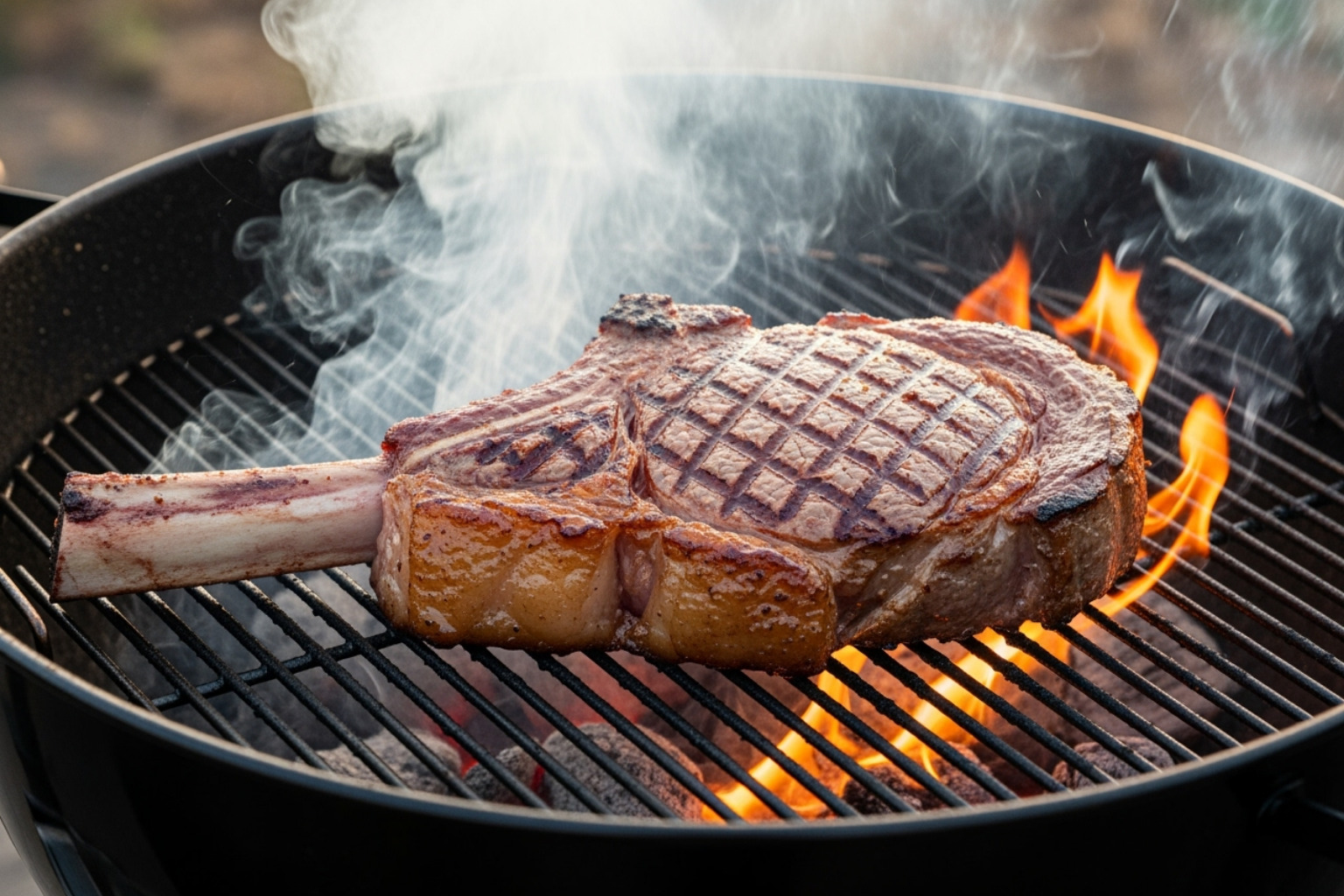
The beauty of this method is that it practically eliminates the common mistakes we see: overcooking the outside while leaving the center cold, not resting the meat properly, and improper seasoning that doesn’t penetrate this thick cut. Whether you’re grilling, pan-searing, or oven-finishing, the reverse sear delivers consistent, restaurant-quality results.
Preparation: The Key to a Flavorful Crust
Great steaks start with great preparation, and this is where many home cooks miss the mark. Let’s set you up for success.
Dry brining is absolutely essential for a 2 lb tomahawk steak. This isn’t just salting – it’s a change process. Generously coat your steak with kosher salt on all sides, then place it uncovered on a wire rack over a baking sheet in the refrigerator. Give it at least 4 hours, but overnight (up to 24 hours) is even better. The salt draws out moisture initially, then gets reabsorbed along with the salt, seasoning the meat deeply while creating the perfect surface for searing.
About an hour before cooking, bring your steak to room temperature. This thick cut needs time to warm up evenly – cold centers are the enemy of perfect doneness. While it’s warming, pat it completely dry with paper towels. Any surface moisture will steam instead of sear, robbing you of that incredible crust.
For seasoning, we keep it simple with such a premium cut. Freshly ground black pepper is essential, and a light dusting of garlic powder adds depth without overpowering the beef’s natural flavor. Some of our favorite local chefs swear by quality beef rubs, but honestly, salt and pepper often showcase this steak best.
The Reverse Sear Method: Step-by-Step
The magic happens in two distinct phases, and having the right tools makes all the difference.
You’ll need an instant-read meat thermometer (seriously, don’t skip this), sturdy tongs, a wire rack and baking sheet, and either a grill or cast iron skillet. If you’re grilling, set up for indirect cooking – pile your charcoal to one side or light only half your gas burners. You want that low indirect heat zone at around 225-275°F.
For the smoking phase, place your 2 lb tomahawk steak on the cooler side of the grill or in a 250°F oven on that wire rack. Insert your thermometer into the thickest part (avoiding the bone), and wait patiently. This isn’t a race – you’re looking for an internal temperature of 115-120°F for medium-rare. This usually takes 45-60 minutes, but remember, temperature trumps time every single time.
Once you hit your target temperature, remove the steak and let it rest for 10-15 minutes under loose foil. This rest period is crucial – it redistributes the juices and prevents them from running all over your cutting board later.
Now comes the fun part: the high direct heat sear. Crank your grill to 450-500°F or get a cast iron skillet screaming hot with a high-smoke-point oil. Sear that rested steak for 1-3 minutes per side, flipping frequently to build an even crust. Don’t forget the edges – that fat cap needs love too!
Here’s a steakhouse secret: butter basting with aromatics takes this steak to another level. Add butter, crushed garlic, thyme, and rosemary to your hot skillet during the last minute. Tilt the pan and spoon that fragrant, golden butter over the steak repeatedly. Pure magic.
Internal Temperatures for Perfect Doneness
Using a meat thermometer isn’t optional with a 2 lb tomahawk steak – it’s your path to perfection. The internal temperature will continue rising during rest periods due to carryover cooking.
For rare, pull the steak at 115-120°F (final temp around 125°F). Medium-rare – our personal favorite – means pulling at 120-125°F for a final temp of 130-135°F. Medium calls for 125-130°F initially, finishing at 135-140°F. Medium-well starts at 130-135°F and lands at 140-145°F, while well-done begins at 140-145°F and finishes at 150-160°F.
The USDA recommends 145°F for food safety, but many steak lovers prefer medium-rare. The choice is yours, but that thermometer ensures you get exactly what you’re aiming for.
Cooking Time for a 2 lb Tomahawk Steak
While every grill and oven behaves differently, here’s what to expect for your 2 lb tomahawk steak timeline.
Plan on about 45-60 minutes for the initial smoking phase, depending on your grill temperature and the steak’s exact thickness. Add 10-15 minutes for the pre-sear rest, then 2-6 minutes total for searing (flipping frequently), followed by another 10-15 minutes of final rest time.
Your total active cooking time runs about 1 to 1.5 hours, but don’t watch the clock – watch that thermometer. Factors like grill temperature consistency, steak thickness variations, and even outdoor weather affect timing.
Why temperature matters more than time becomes crystal clear with thick cuts like this. A timer might work for thin steaks, but a 2 lb tomahawk steak demands precision. Trust your thermometer, and you’ll nail it every single time.
Mastering the Art of Serving
After all that careful preparation and cooking, you’re finally ready for the best part – serving your magnificent 2 lb tomahawk steak. Here in New York City, we know this final stage can make or break your entire culinary masterpiece, so let’s make sure you nail it.
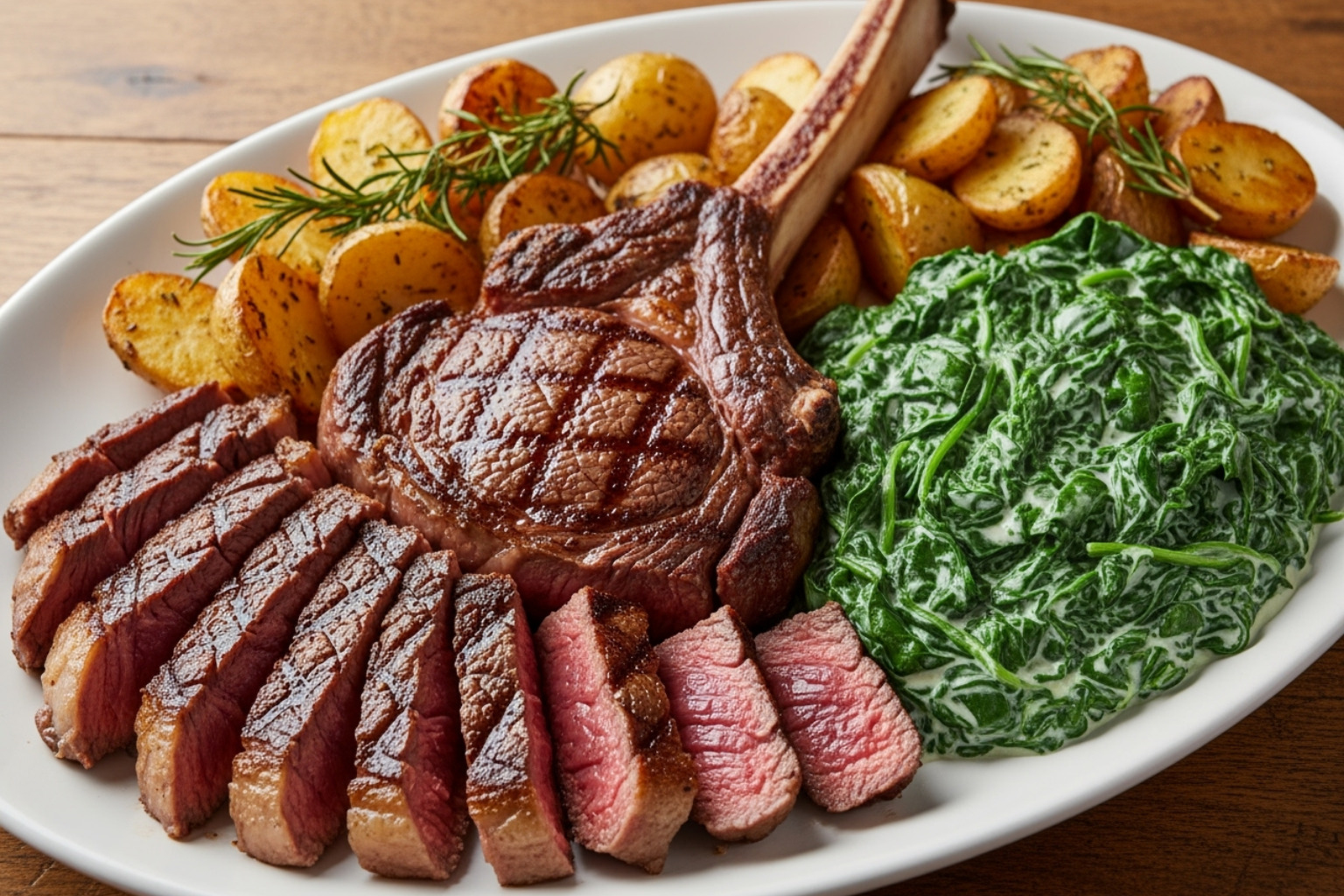
Resting the Steak
Here’s where patience becomes your best friend. After that beautiful sear, resist the urge to dive right in. Instead, transfer your 2 lb tomahawk steak to a cutting board and tent it loosely with foil – and we mean loosely. Wrapping it tightly will steam that gorgeous crust you worked so hard to achieve.
Let it rest for 10-15 minutes minimum. This isn’t just food snobbery – it’s actual science working in your favor. During cooking, all those delicious juices get pushed toward the center as the muscle fibers contract. Resting allows everything to relax and redistribute those juices throughout the meat.
Think of it this way: cut too early, and you’ll watch your steak’s life force drain onto the cutting board. Wait those crucial minutes, and every bite will be juicy perfection. Plus, the internal temperature will climb another 5-10°F during this time, which we’ve already factored into our cooking temperatures.
Carving Technique
Now comes the theatrical finale – carving your masterpiece. Start by carefully slicing the meat away from that impressive bone. Some folks like to pass the bone around as an appetizer (hey, no judgment here!), while others save it for making incredible bone broth later.
The real key to tender slices is cutting against the grain. Look closely at your steak and you’ll see the direction of the muscle fibers – that’s the grain. Slice perpendicular to those lines, not parallel. This shortens the muscle fibers, making each bite melt-in-your-mouth tender instead of chewy.
Aim for slices about half to three-quarters of an inch thick. Fan them out on a warm platter and drizzle with any juices that accumulated on your cutting board – that liquid gold shouldn’t go to waste.
Recommended Side Dishes and Pairings
A 2 lb tomahawk steak deserves supporting players that won’t steal the show but will definitely improve the performance. Roasted potatoes are a classic choice – whether you go with crispy roasted fingerlings, creamy garlic mashed, or an indulgent gratin, potatoes and steak are a match made in culinary heaven.
Creamed spinach brings that traditional steakhouse vibe, with its rich, savory profile balancing the beef’s intensity beautifully. For something fresh and vibrant, grilled asparagus or green beans add a lovely char and crisp texture that cuts through all that richness.
Garlic butter mushrooms are another winner, bringing earthy, umami depth that complements the beef’s bold flavor. And here’s a pro tip: whip up some compound butter while your steak rests. Just mix softened butter with minced garlic, fresh herbs like rosemary or thyme, and a pinch of salt. A pat of this melting over your hot steak slices creates an instant luxurious sauce.
For drinks, a bold red wine like Cabernet Sauvignon or Merlot stands up beautifully to the rich, beefy flavors. If you’re not drinking alcohol, a sparkling water with lemon or robust iced tea makes an excellent palate cleanser.
Common Mistakes to Avoid
Even experienced cooks can stumble when handling such an impressive cut. Not letting it rest is the biggest sin – we can’t stress this enough. Your patience will be rewarded with juicy, perfect slices.
Slicing with the grain instead of against it will leave you with tough, chewy meat no matter how perfectly you cooked it. Using a pan that’s too small during searing leads to steaming instead of that gorgeous crust you’re after.
Choosing the wrong oil for searing is another pitfall – olive oil will burn and turn bitter at high heat, so stick with high-smoke-point oils like avocado or grapeseed oil. And please, invest in a good meat thermometer instead of guessing. Your expensive 2 lb tomahawk steak deserves better than guesswork.
Finally, never cook it straight from the fridge. That leads to an overcooked exterior and raw center – definitely not the even doneness you’re aiming for.
Frequently Asked Questions about Tomahawk Steaks
After helping countless New York City food enthusiasts master the art of cooking tomahawk steaks, we’ve noticed the same questions come up time and again. Here are the answers to what people really want to know about this impressive cut.
How many people does a 2 lb tomahawk steak feed?
The beauty of a 2 lb tomahawk steak is its generous size – it’s perfectly portioned for 2-4 people depending on your appetites and what else you’re serving. For two serious steak lovers, it creates an indulgent, romantic dinner that feels like a special occasion.
When we’re hosting dinner parties with hearty side dishes like roasted potatoes and creamed spinach, we find it easily satisfies three to four guests. The rich marbling means a little goes a long way – this isn’t a lean cut where people need huge portions to feel satisfied.
Tomahawk steaks are designed for sharing. There’s something wonderfully communal about carving up this impressive piece of meat and passing around the perfectly cooked slices. It’s as much about the experience as it is about the meal itself.
Is the bone just for show or does it add flavor?
This is honestly one of the most hotly debated questions in the steak world! The truth is, that dramatic 5- to 8-inch frenched bone is primarily there for aesthetic appeal and practical handling. It gives you that incredible “caveman food” presentation and works as a natural handle when you’re flipping the steak on the grill.
Does it add flavor to the meat? The impact is pretty minimal during the actual cooking process. The bone doesn’t penetrate deep enough into the meat to significantly change the taste of your 2 lb tomahawk steak.
But here’s where it gets interesting – that bone isn’t useless after dinner! Save it to make an incredibly rich bone broth for future soups and sauces. The marrow and connective tissue create deep, savory flavors that transform simple broths into restaurant-quality bases. So while it’s mostly for show during cooking, it definitely has culinary value if you’re willing to put it to work later.
What’s the difference between a tomahawk and a cowboy steak?
Both cuts are bone-in ribeyes from the same primal section, so they share that incredible marbling and buttery flavor we all love. The difference is all about the bone length.
A tomahawk steak features that signature long, frenched bone – usually 5 to 8 inches or even longer. This creates the dramatic “handle” that resembles a tomahawk axe, hence the name. It’s the ultimate showstopper cut.
A cowboy steak, on the other hand, has a much shorter bone – just a few inches long. It’s still frenched and cleaned, but without that theatrical presentation. Think of it as the tomahawk’s more practical cousin.
Both deliver the same incredible eating experience, but if you want maximum visual impact for your 2 lb tomahawk steak dinner, the longer bone wins every time. It’s the difference between impressive and absolutely unforgettable.
Conclusion: Your Next Culinary Adventure Awaits
There’s something magical about conquering a 2 lb tomahawk steak in your own kitchen, and here in New York City, we believe it’s an experience every food lover should have. It’s not just about the incredible flavor or the impressive presentation – though both are absolutely worth celebrating. It’s about that moment when you slice into a perfectly cooked steak and see that beautiful pink interior, knowing you’ve mastered one of the most challenging and rewarding cuts in the culinary world.
Throughout this guide, we’ve walked you through every step of the tomahawk journey. From sourcing that perfect cut at your local butcher shop to understanding the reverse sear method that transforms a thick piece of meat into steakhouse perfection. We’ve covered the importance of dry brining for deeper flavor, the critical role of your meat thermometer for achieving that ideal doneness, and why resting your steak is absolutely non-negotiable.
The 2 lb tomahawk steak represents more than just dinner – it’s a culinary adventure that brings people together. Whether you’re celebrating an anniversary, impressing dinner guests, or simply treating yourself to something extraordinary, this magnificent cut delivers an experience that creates lasting memories.
Remember the fundamentals that make all the difference: patience during the slow cooking phase, precision with your temperatures, and confidence during the final sear. These aren’t just cooking techniques – they’re the building blocks of culinary mastery that you can apply to countless other dishes.
The beauty of cooking a tomahawk steak at home is that you get all the drama and flavor of a high-end steakhouse experience at a fraction of the cost. Plus, there’s an undeniable satisfaction in serving something this impressive to the people you care about.
Ready to fire up your grill and create your own steakhouse moment? Your next food adventure with our guide to the tomahawk steak is just waiting to begin. Trust us – once you’ve mastered the 2 lb tomahawk steak, you’ll never look at grilling the same way again.

